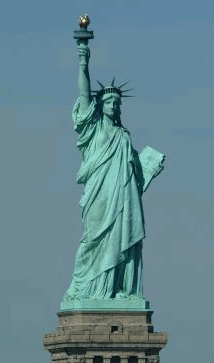This political cartoon has special resonance for me:
 |
| "Passing the Torch: Tiananmen Square . . . Tehranimen Square" |
It alludes to the "Goddess Democracy" statue that was erected in Tiananmen in 1989:
 |
| "Goddess of Democracy" statue Tianmen Square, 1989 |
I remember at the time being at a meeting in Washington, DC, of business executives doing business with China. A small group of people was talking, and one American woman said, "Yes, but don't you think they went too far with the 'Democracy' statue?"
That was the moment when everything changed for me . . . .
 |
| Statue of Liberty |
(For a full set of images from 01/01/10 in Hong Kong, see: http://picfog.com/search/0101hk)
See Visual Imagery of Hong Kong Protests Jan 1 2010
Other related posts
Beijing has an intuitive understanding that, in a way that is determined by conditions of unequal information, it can monolithically dictate terms, and that other, "distributed," parties will be hard-pressed to stand up to those terms. Specifically, Beijing observes a cynical cost/benefit calculus which says, "Sure, a few players will always wise up and exercise their options to move away from us; but, by and large, everyone else is too paralyzed to move."
(See Merry Christmas, Mr. Liu: The Prisoner's Dilemma in China)
Despite the difficulties associated with engaging in effective solidarity with dissidents in China, it is important to make the effort. A fundamental tenet of all peace and justice activism is that if we have the power to speak we can do anything, and if "they" succeed in shutting us up, it's the beginning of the end.
(See What is the US Peace and Justice Movement Doing for Dissidents in China?)
"How can it be that no one is speaking directly to what happened?" I wondered. "Should I say something? Is it just me? Can it be possible that most people aren't like me, tremendously troubled by how we should respond to what has happened in China?"
(See Remember June 4)
Recent events have not only proved that dissent is alive and well in Hong Kong, but that creative resistance is a Hong Kong strong suit. The June 4, 2014, commemoration of the Tiananmen Massacre in Hong Kong included these images . . .
(See Hong Kong Keeping the Memory of June 4 Alive (Who Knew?) )
The resistance art on the West Bank wall has become iconic for the movement to resist the Israeli occupation of Palestine. As a part of our preparation for this prayer justice walk on Good Friday, we created some sign boards that replicate art found on the Wall (also known as the Separation Barrier) in Israel. Palestinians and visitors from throughout the world have added their own street art, graffiti, and public art to the Wall, as a sign of protest, an invitation to peace, and a critique of the lack of global intervention. We are posting pictures of our recreations of some of these sign boards in honor of those amazing artists (some known and others anonymous). These signs should help each of us consider what our own role could be in ending the injustice in the Middle East – whether gaining further personal awareness about the Wall, writing to a legislator, reading more about the plight of Palestinian people, or supporting a justice organization working in the Middle East.
(See Completed "Wall" sign boards - for Good Friday event on the Working Group on the Middle East (MCS, ELCA) website.)





No comments:
Post a Comment